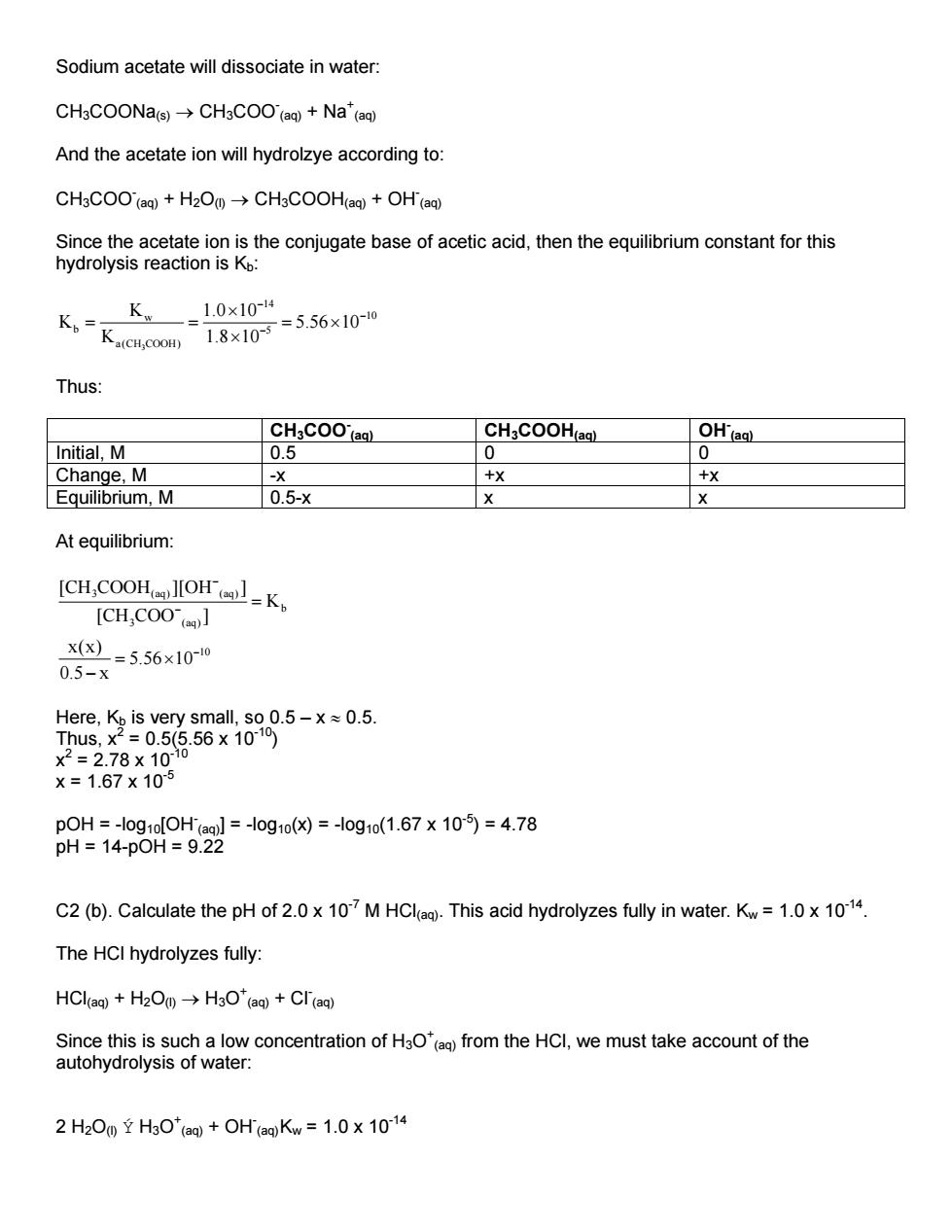正在加载图片...

Sodium acetate will dissociate in water: CH3COONa(s)>CH3COO(ag)+Na'(ag) And the acetate ion will hydrolzye according to: CH3COO(ag)+H20>CH3COOH(aq)+OH(aQ) Since the acetate ion is the conjugate base of acetic acid,then the equilibrium constant for this hydrolysis reaction is Ko: K1.0x10-4 =5.56x1010 1.8×10 Thus: CH3COO(ag) CH3COOH(ag) OH'(eg) Initial,M 0.5 0 +x 0.5-x At equilibrium: [CH,COOH=K [CH,COO ) x)=5.56×10-0 0.5-x =05556x100-X0.5. 78× pOH =-log10[OH (ag)]=-log10(x)=-log10(1.67 x 105)=4.78 pH=14-p0H=9.22 C2(b).Calculate the pH of 2.0x107M HCl).This acid hydrolyzes fully in water.K=1.0x104. The HCI hydrolyzes fully: HClag)+H2O>H3O(aQ+Cr(aQ) Since this is such a low concentration of HaO'(ag from the HCI,we must take account of the autohydrolysis of water 2 H2O0H3O'(ag)+OH(ag Kw=1. Sodium acetate will dissociate in water: CH3COONa(s) → CH3COO- (aq) + Na+ (aq) And the acetate ion will hydrolzye according to: CH3COO- (aq) + H2O(l) → CH3COOH(aq) + OH- (aq) Since the acetate ion is the conjugate base of acetic acid, then the equilibrium constant for this hydrolysis reaction is Kb: 3 14 w 10 b 5 a(CH COOH) K 1.0 10 K 5 K 1.8 10 − − − × = = =× × .56 10 Thus: CH3COO- (aq) CH3COOH(aq) OH- (aq) Initial, M 0.5 0 0 Change, M -x +x +x Equilibrium, M 0.5-x x x At equilibrium: 3 (aq) (aq) b 3 (aq) 10 [CH COOH ][OH ] K [CH COO ] x(x) 5.56 10 0.5 x − − − = = × − Here, Kb is very small, so 0.5 – x ≈ 0.5. Thus, x2 = 0.5(5.56 x 10-10) x2 = 2.78 x 10-10 x = 1.67 x 10-5 pOH = -log10[OH- (aq)] = -log10(x) = -log10(1.67 x 10-5) = 4.78 pH = 14-pOH = 9.22 C2 (b). Calculate the pH of 2.0 x 10-7 M HCl(aq). This acid hydrolyzes fully in water. Kw = 1.0 x 10-14. The HCl hydrolyzes fully: HCl(aq) + H2O(l) → H3O+ (aq) + Cl- (aq) Since this is such a low concentration of H3O+ (aq) from the HCl, we must take account of the autohydrolysis of water: 2 H2O(l) Ý H3O+ (aq) + OH- (aq) Kw = 1.0 x 10-14